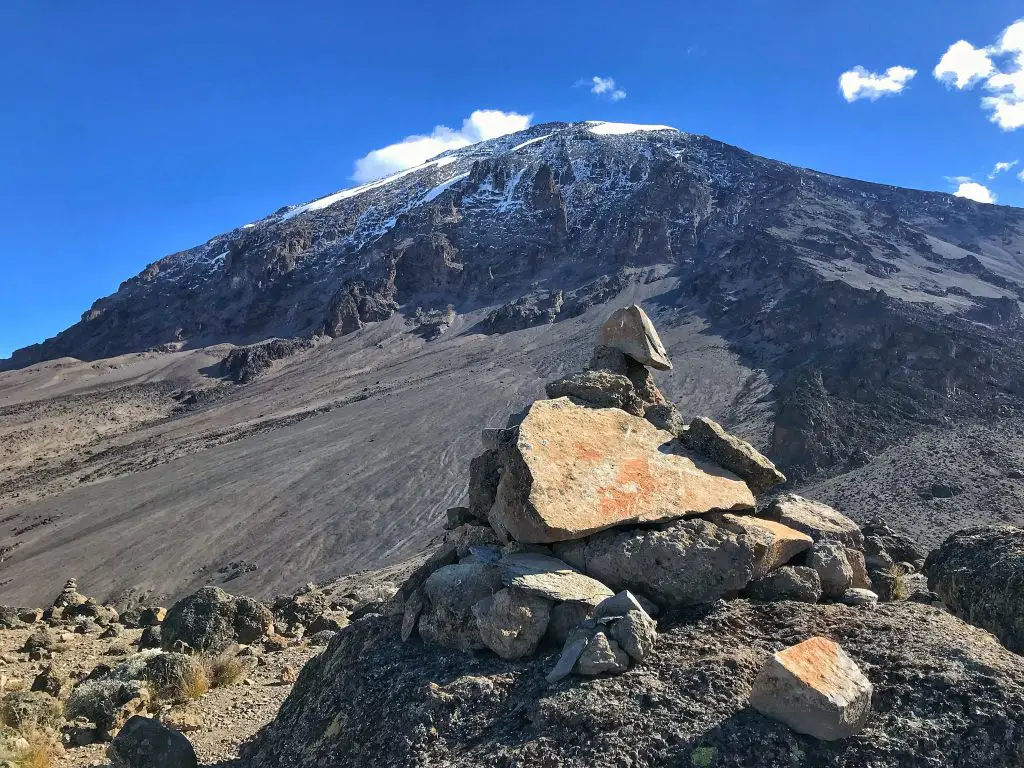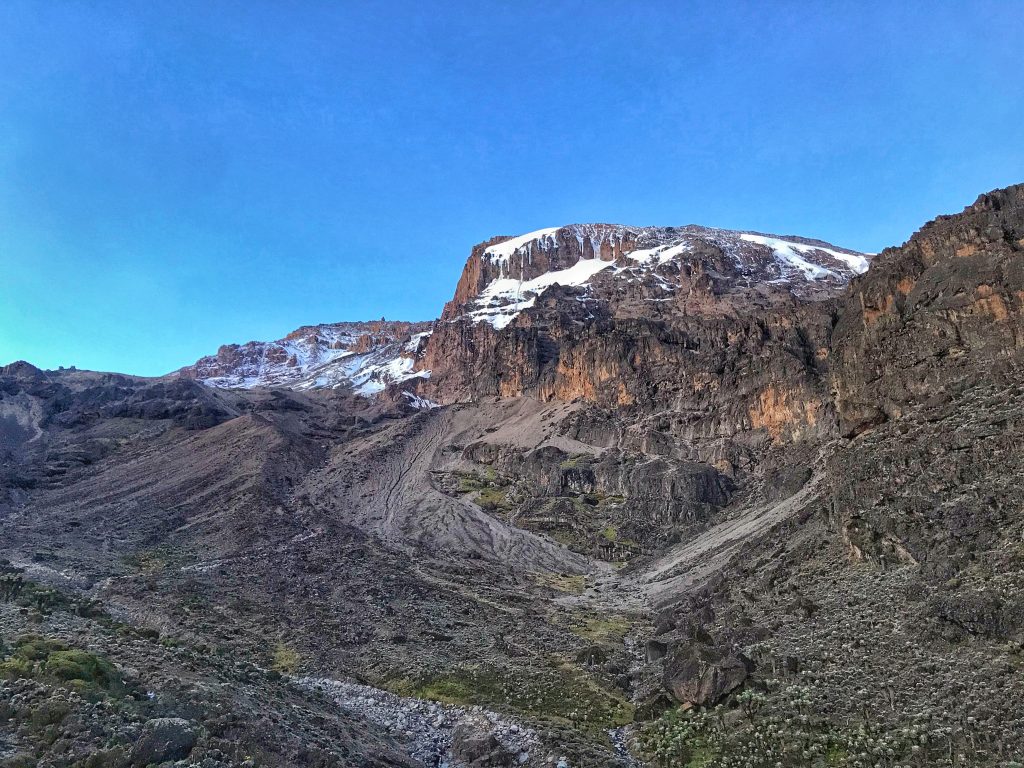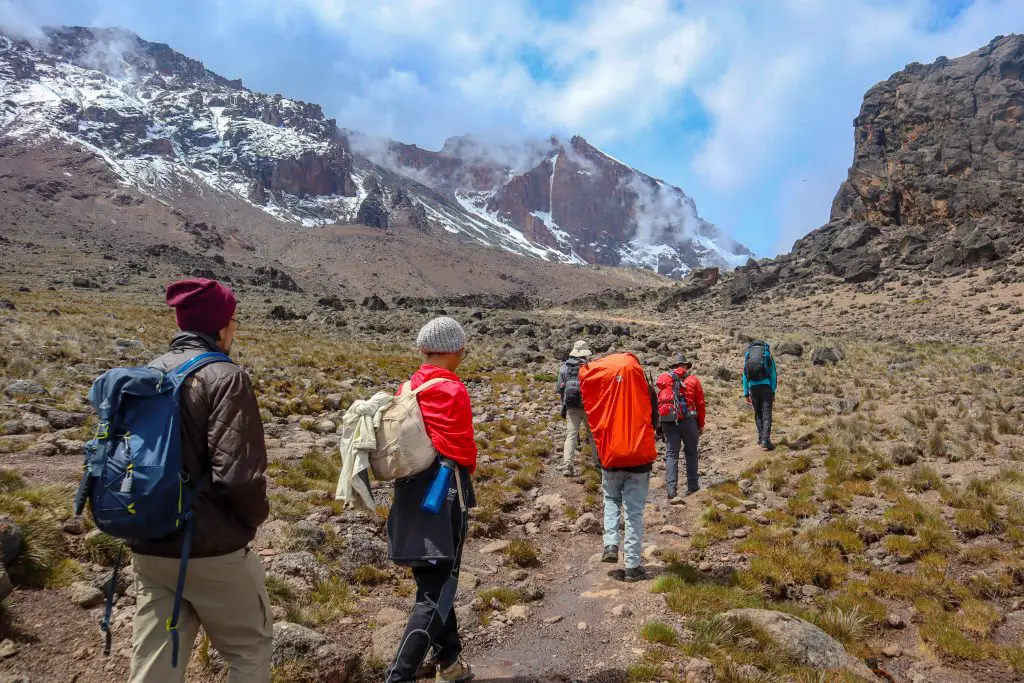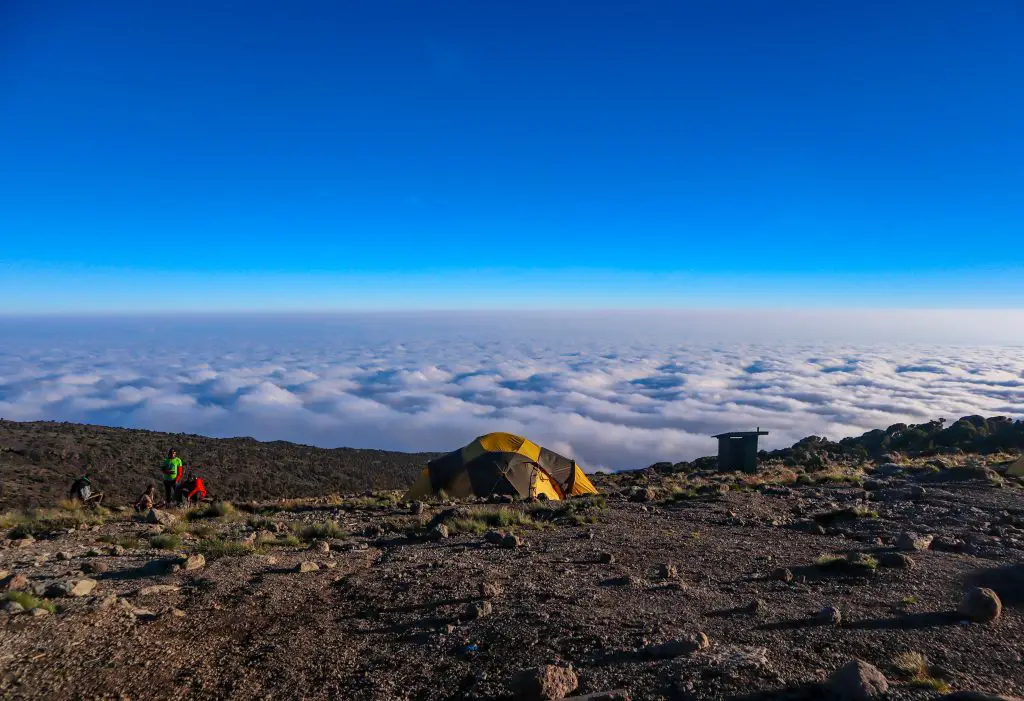Le Kilimanjaro, one of the seven tallest peaks in the world is the roof of africa. Its climax, the Uhuru peak, it is located at 5 m altitude.
Kilimanjaro is located at North East Tanzania, on the border with Kenya.
When is the best time to climb Kilimanjaro?
The ascent of Kilimanjaro can be done throughout the year. However, some periods are favorable and others are less so.
The country enjoys a equatorial climate with a very pleasant temperature throughout the year.
We find two periods of rain in Tanzania:
- March to June
- October to December
In general, you will be advised toavoid climbing Kilimanjaro during these rainy periods.
However, be aware that it depends on how much time you have. With climate change, it is possible to fall on a week without rain during the rainy season or, conversely, to fall on a week of rain during the "best periods".
Personally, I did Kilimanjaro the first week of June, although it was the end of the rainy season, we enjoyed wonderful weather.
Is climbing Kilimanjaro difficult?

This is a very often asked question. You can find many informations to answer this question on the internet.
The ascent of Kilimanjaro does not does not require any particular mountaineering experience. Indeed, the little snow that remains on the summit, does not require the use of professional technical equipment.
Climbing Kilimanjaro can be achieved by anyone with minimal physical conditions.
The ascent of Kilimanjaro is quite simply a 4-9 day hike at high altitude. So there is no real technical difficulty to get to the top of Kilimanjaro.
To climb Kilimanjaro, you have to be at least 10 years old. When I made the climb, I was surprised to meet an 80 year old American woman who was doing the trek with her daughter.
Statistics suggest a 50% average success rate. This rate fluctuates, it all depends on the route chosen to reach the top.
Can we climb Kilimanjaro without training?
Climbing Kilimanjaro does not require special mountaineering knowledge.
However, can we really consider to tackle the highest peak in Africa, which is nearly 6 m, without any training ?
Honestly I think it doesn't seem like not very serious.
However, is it necessary to follow a drastic training to maximize your chances of reaching the summit of Kilimanjaro?
The ascent of Kilimanjaro does not requiring no technical expertise, it is still a hike over several days at a high altitude.
Ce summit is accessible to everyone, however, it is still necessary tohave a minimum of physical conditions.
A sporty person should arrive at the top of Kilimanjaro without any worries.
A very athletic person should not need more training than their usual training.
To give you an idea, a training running several times a week should be enough for a sporty person.
Know that there is a very important parameter to take into account when embarking on the ascent of Kilimanjaro. This parameter is altitude.
Whether you are sporty or not, the resistance to altitude is unique to each person. There is no other way to see its effect on your body than to directly confront yourself with an altitude test.
What physical conditions do you need to climb Kilimanjaro?

In order to maximize your chances of reaching the summit of Kilimanjaro, it is important tohave a minimum of physical conditions. Indeed, the ascent taking place over several days, it is necessary to be able to withstand the effort for several days.
Must therefore train over time, long distances and repeated efforts.
An athlete will have no problem resisting these efforts. On the other hand, a person not practicing any sporting activity will necessarily have to do it because it a minimum of physical training is required to be able to reach the top.
How to train for the ascent of Kilimanjaro?
Statistics show that only 50% of those attempting to climb Kilimanjaro reach its summit.
Obviously, when you embark on such an adventure, you really want to reach the top.
To do this, it is necessary to prepare as well as possible for the ascent.
After having lived this extraordinary experience, I advise you :
- To have regular physical activity a few months before leaving for Kilimanjaro: for example, running, or any other sporting activity. You need regular activity that will allow you to withstand the strain over time.
- Train in conditions similar to the trek: namely to go trekking in the mountains to acclimatize your body to the altitude. Obviously, you will not find hiking in France at an altitude of around 4 or 000 m easily accessible. But all the same, a few outings in the mountains before your departure will do your body a lot of good.
What should you prepare for to climb Kilimanjaro?
Depending on the options you have chosen when booking the trek, there are some peculiarities to have in mind when preparing for this trek:
- Hygiene : there is no shower so you will have to make do with small basins of hot water to wash your face in particular. A word of advice, you can bring intimate wipes, it can be very useful to clean yourself up.
- Meals : it all depends on the options chosen, but you will be entitled to a cook who will concoct good meals for you. You will be entitled to "European" dishes for lunch and dinner (soup, salad, meat, rice, pasta, fries etc.). Also, tea and popcorn will be distributed throughout the trek.
- Cold : the first days, during the day, the temperatures are pleasant. Personally, I spent a large part of the trek with only a breathable long sleeve t-shirt. At sunset, the temperatures drop significantly and you have to cover yourself with small down jackets. The night can be very cold. In particular, I used my water gourds as a hot water bottle to warm myself in the sleeping bag. The final ascent is the most complicated period to go through. We have to get up at 23 pm, when everything is frozen around us and then we start the ascent. Initially, I did not put on my biggest puffer jacket since the physical effort allowed me to warm up. However, the slightest little break of 5 minutes cooled me deeply. The moment came when I had to put on my big puffer jacket with several layers at the top and bottom. On reaching the top, it is so cold that the clothes, bags, hats freeze. It can be between -10 and -20 degrees at the top. Prepare for this temperature !!
- Tiredness : The days can be long and tiring during the trek. Note that as a general rule you will walk between 4 and 6 hours per day. This will give you time to rest once you arrive at the camp because in fact the walk takes place in the morning with an arrival in the beginning / mid-afternoon at the next camp. The important thing is to keep your strength for the final ascent where you will walk only 7 hours to reach the top. I recommend that you carefully follow the advice of the guides, namely not to walk too fast, even if you feel in good shape. You will often be told to go "pole, pole" which means "slowly, gently".
- the Motivation box : “When you want, you can”, this well-known proverb sums up the ascent of Kilimanjaro. Finally, indeed other factors that can be outside our will come to skew this proverb, namely altitude sickness. However, your motivation and determination will bring you to Kilimanjaro, especially at the time of the final ascent, when you will be tired with more difficult breathing during the slightest effort. Motivation and determination is the key to success.
- Mountain sickness : altitude is probably the parameter not to be underestimated and the most dangerous when launching an assault on the roof of Africa. Indeed, each human being has his own reaction to altitude, regardless of whether one is a great athlete or not. We must therefore pay close attention to the slightest symptoms that we can develop throughout the ascent. Mountain sickness is a reality on Kilimanjaro. Poor acclimatization can cause serious headaches, nausea, vomiting etc. It is very important to take this seriously and talk to your guide as soon as possible when you are not feeling well. Physical training allows you to have fewer unpleasant symptoms during the ascent, but the best way to combat altitude sickness is to have a slow progression and drink plenty of water. Drinking water is extremely important, don't forget this. "Walk high and sleep low" this phrase is well known in the mountain world. This is a rule that must be followed. The more time you spend getting acclimatized, the higher your chances of success will be.
The ascent of Kilimanjaro can be achieved by anyone in good physical condition, but other criteria may also be taken into account.
Similar items
Climbing Kilimanjaro is an extraordinary adventure to experience. Here is my testimony of this extraordinary experience that I lived.
Many agencies offer to climb Kilimanjaro. But then which one should you choose?
Are you ready to embark on this adventure ?! However you still wonder what equipment it is necessary to bring for such a climb ?!
If you liked this article, I recommend one of the following articles on the same theme:
- Can we climb Kilimanjaro without a guide?
- The ascent of Kilimanjaro: what price?
- The ascent of Kilimanjaro: how difficult is it?
- My 5 day safari in Tanzania
- My humanitarian travel experience in Zanzibar
- What to do in Tanzania?
- What to do in Zanzibar?
- Learn the basics of Swahili
- 10 Day Zanzibar Itinerary
- 3 week itinerary in Tanzania
- 15-day itinerary in Tanzania
- How to travel in Tanzania on a low budget?



Beautiful pictures! I have also been thinking about climbing Kilimanjaro for some time but don't dare to go for it! Thank you for this article which enlightened me a lot!
Good continuation
Thank you Guillaume!
I advise you to go for it if you wish because it is a great once-in-a-lifetime experience!